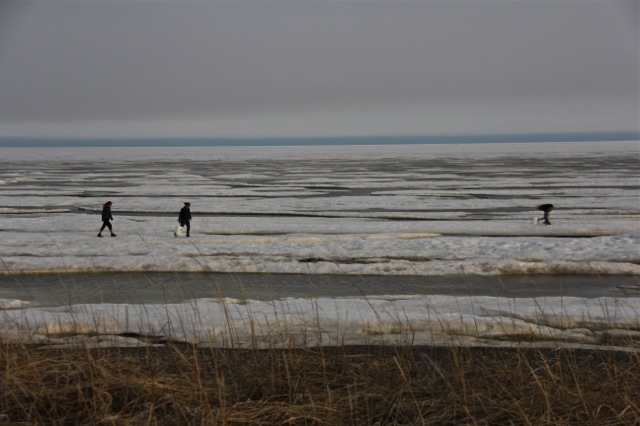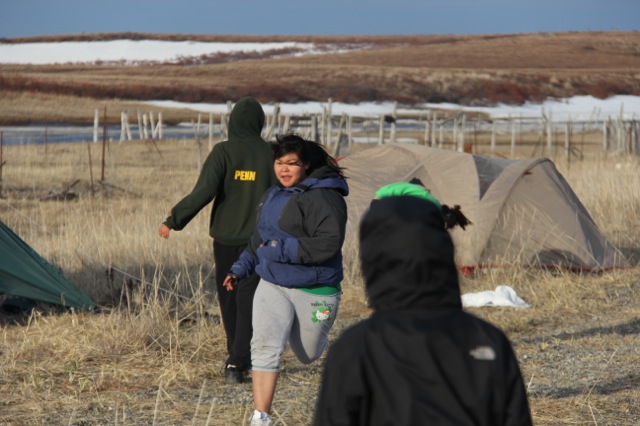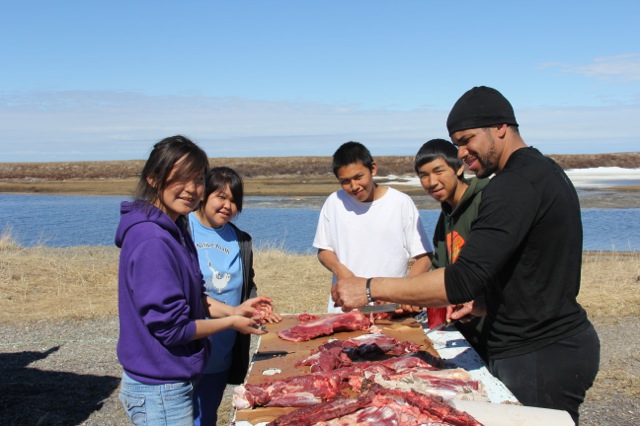It was approaching ten in the evening, the sun still high in a distant lightly clouded arctic sky, hanging over a late spring tundra. The youth were playing Norwegian, a form of baseball with two sides as opposed to four bases, on our gravel spit campsite. The ocean was frozen, but melted a little each day, just enough for us to leap the saltwater gaps to find fresh water in the middle of icebergs for cooking, washing, and quenching our thirst.
One of the Inupiaq youth, Joe, decided to look inland towards a small hill, squinting his eyes a bit, while in the outfield. I was standing nearby with one of the other camp leaders, a knowledgeable Yupik woman named Aucha. She asked, “What you see Joe?” He replied, “Over there, it’s something.” It was something. We pulled out my rifle with scope to take a closer look. Several caribou proceeded to follow the first over the hill, heading further inland.
Another camp leader named Bryan, Joe, and myself quickly geared up to take a walk inland. The tundra surrounding our camp was part swamp, part mud, and part dry toward the hills. We cut through some mud to get downwind and in front of the direction the caribou were headed. We relied on Joe’s good eyes and Bryan’s drive to keep us moving in the right direction, despite miles of sweat inducing pursuit. We crawled up on a hill with the caribou nearly five hundred yards in the distance. The land was too open for us to approach any more, so we decided that I should take a shot from there. We got lucky that evening.
We skinned and quartered the caribou, wrapped half in the hide and tied it to one meat pack. We tied the other half to the other pack we brought. We kept every part of the animal we could use, including the head. The three mile hike back to camp took some time, even though we only took two short breaks. Being on the land like that, we realize how tough our ancestors were, and how much more we need to use our bodies to keep strong and fit.
Others set up a wood rack and began cutting the meat to make nilii ghaii / paniqtuk (Native style jerky). After cutting some hindquarter for meat and gravy, I began to work on skinning the caribou head to begin cutting meat from it for caribou head soup, which is a delicacy among my people. Despite having watched my mom and other Gwich’in women prepare the soup plenty, this was my first time to be responsible for the entire process. I think that only two people had ever tried caribou head soup in the camp, one of who was our elder Inupiaq cook. She was so happy to have some, as were all the other camp leaders and youth. I had my fill as well.
The land and animals provided for us this week and the knowledge of our peoples emerged, not only securing our physical survival, but in guiding us to address each physical, emotional, and spiritual challenge that arose. We learn through experience, we grow with practice, and we give thanks for all that we are blessed to receive.
Tundra Dialogues is a new interactive blogging site, hosted by Evon Peter. The project will host conversations on personal, cultural, and spiritual growth. The vision is to inspire and inform positive change in the lives of individuals, families, communities, and the world. All people from any spiritual, cultural, and personal background are welcome to join the dialogues.
Evon will share reflections from his life of walking the path on the home blog, where anyone can engage with him in posts that capture their interest. The community blog will be open for any registered Tundra Members to make a formal blog post, but still be open to anyone in the public for comments to carry the dialogue forward. It is free to register as a Tundra member!







